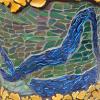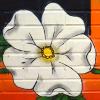Quilts From Gee's Bend, Photos From Syria: On View at the Georgia Museum This Fall
Art Notes

"Starr Attraction" by Mary Lee Bendolph
Before the War: In 2009, architectural photographer Peter Aaron traveled through Syria with his family, capturing images of city streets and historic monuments along the way. Two years later, as part of the Arab Spring uprisings, a civil war broke out that has continued into the present day. On view at the Georgia Museum of Art through Dec. 1, “Before the War: Photographs of Syria by Peter Aaron” takes a look back at significant sites that have been forever destroyed through conflict. His black-and-white scenes reveal architecturally fascinating and culturally complex areas of Syria, which over the centuries has played host to religious and civic buildings for Islamic, Jewish, Christian, Roman and Ottoman peoples. Albeit scarred, these ancient structures reflect the marks of multiple civilizations and continue to provide a home for contemporary activity.
Quilted Memories: For many residents living during the civil rights movement in Gee’s Bend, AL, a small rural community located not far from Selma, the traditional craft of quilting involved more than just making textiles. On an individual level, the process provided moments for self-reflection and healing, and on a community-wide level, the collaborative activity offer occasions for singing, conversation and prayer. One such quilt-maker, Mary Lee Bendolph, accompanied Dr. Martin Luther King Jr. in his march at Camden, AL, in 1965 and, following the experience, felt inspired to continue demonstrating for voting rights. On view through Dec. 29, “Mary Lee Bendolph: Quilted Memories” focuses on this particular quilt maker who played a central role in this special community.
Born into a family with several generations of quilt-makers, Bendolph learned from her mother, Aolar Carson Mosely, who was one of over 100 women who founded the Freedom Quilting Bee in 1966, a craft cooperative intended to create economic opportunities for African-American women. Often working with recycled fabrics and clothing scraps of family members, a detail that symbolically weaves in memory, Bendolph has developed a unique style that reflects personal stories, local architecture and daily life images. For this exhibition, a total of 17 quilts that span three decades were selected to showcase her colorful, geometric designs.
Rachel Whitread: Outdoors in the Jane and Harry Willson Sculpture Garden, a tranquil courtyard devoted to displaying works by women sculptors, British artist Rachel Whitread’s five cast-stone creations give shape to the nothingness of negative space. Reinterpreting an earlier series of resin castings, the works illuminate the invisible air beneath chairs. The unusual blocks are arranged in a rectangular formation, not unlike a table setting, to hint at their domestic nature. On view through Mar. 7, the sculptures are supplemented with a display on the museum’s second floor of selected works on paper by Whitread and other artists who reinterpret space and voids.
Drama and Devotion: Active in Rome from the mid-1590s to his death in 1610, Michelangelo Merisi da Caravaggio revolutionized Italian painting through his use of starkly contrasted lighting, powerful realism, live models and dramatic staging. On view through May 31, the exhibition “Drama and Devotion in Baroque Rome” celebrates Caravaggio’s influence through six paintings on loan from the Museum and Gallery at Bob Jones University in Greenville, SC.
Though very few of Caravaggio’s paintings appear in North American collections, his distinct style is reflected through the works of his admirers. Flemish artist Peter Paul Rubens’ painting “Christ on the Cross” is a focal point, with its dark, stormy sky and deep expression of suffering and sacrifice. French artist Trophime Bigot demonstrates Caravaggio’s chiaroscuro—Italian for “contrast in light”—in “Saint Sebastian Tended by Saint Irene,” in which his injured body is illuminated against a dark background by a lantern. “Drama and Devotion” also includes works by French artist Simon Vouet, Flemish painter Abraham Janssen and Italian artists Orazio Gentileschi and Giovanni Lanfranco.
Several other exhibitions are scheduled to open before the year’s end. “Material Georgia 1733–1900: Two Decades of Scholarship,” opening on Nov. 16, presents various pieces of furniture, textiles, pottery and metal work selected from the museum’s Henry D. Green Center for the Study of Decorative Arts. Both opening on Dec. 21, “Master, Pupil, Follower: 16th to 18th Century Italian Works on Paper” will offer drawings and prints reflecting different artistic styles and Italian regional schools, while “The Monsters Are Due on Broad Street: Patrick Dean” provides a retrospective look at the cartoonist and beloved Flagpole contributor’s illustration career
More by Jessica Smith
-

Art Around Town
A list of local art exhibits.
-

-

Art Around Town
A list of local art exhibits.









comments